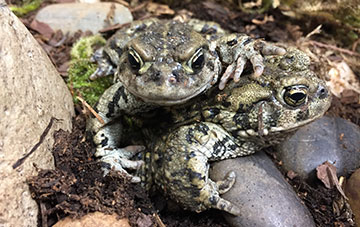

Amphibian populations are experiencing dramatic decreases resulting in the establishment of captive assurance colonies to serve as a hedge against extinction. Unfortunately, these captive assurance colonies are beginning to fail due to low reproductive output and aging animals. In order to save a portion of our unique North American amphibian diversity, assisted reproductive technologies along with cryopreservation strategies must be developed before genetic diversity is lost and wild populations go extinct. The amphibian genome resource bank located at MSU serves as a repository for reproductive cells from male founder lines that will be able to contribute to offspring production in the future. The amphibian genome resource bank uses our expertise in the field of cryobiology to preserve spermatozoa from threatened and endangered amphibian species. A lot of this knowledge has been generated “in-house” in our lab at Mississippi State University and now we aim to apply this information to aid conservation and breeding efforts for amphibian species. We work closely with zoos and aquariums to focus our efforts on specific species that are at-risk of losing valuable genetic material forever.
Under the auspices of Dr. Carrie K. Vance and Dr. Andrew J. Kouba, the lab has developed effective methods for cryopreserving male reproductive cells for a variety of at-risk amphibian species. Further, Dr. Vance and Dr. Kouba have worked closely with the association of zoo and aquarium amphibian community for over 15 years and remain in constant contact with partner institutions when determining new objectives and target species for the genome resource bank.
A Genome Bank (also called Genetic Resource Bank or Biomaterial Bank) is a frozen storage area designed to preserve genetic materials from animals and may include eggs, sperm, embryos, tissues, blood, hair, or cells. The idea behind a genome bank is that the biological material can be deposited and withdrawn to facilitate genetic management of threatened species or assist with scientific research (e.g. disease). The process of freezing these materials is called cryobanking or cryostorage, and usually involves cooling materials to sub-zero temperatures in liquid nitrogen (-196°C) before placing them into special cryopreservation storage tanks. Prior to freezing, the biological materials are often placed in a buffering solution (solutions that maintain a constant pH) and cryoprotectant (substances that protect biological cells/tissues against damage due to ice crystal formation, osmotic stress, and oxygen generation). Genome banks allow for the long-term viable storage of genetic materials that would otherwise degrade or become unviable very quickly.
Genome banks, unlike general tissue banks, typically store reproductive cells for the express purpose of propagating a species at a later time. Stored amphibian reproductive cells can be thawed at a later date and used for in-vitro fertilization (IVF) to create viable embryos and tadpoles. Genome banks have been established all over the world for the conservation of charismatic endangered mammal species [Wildt et al., 1997] but have been relatively ignored for amphibians. The benefits of storing amphibian materials in cryobanks are:
For more details on the advantages of maintaining an Amphibian Genome Bank, please consult our Amphibian GRB publications page.
With the collapse of amphibian populations across the globe, conservation programs are incorporating captive breeding and reintroduction back into the wild to stem further losses of wild populations. However, breeding amphibians in captivity is challenging due to the difficulties of simulating environmental conditions necessary for natural reproduction. Biologists are circumventing these captive breeding issues by developing assisted reproductive technologies (ART), such as in-vitro fertilization. This is where the amphibian genome resource bank has found its niche, and link to conservation, by storing genetic material which can be deposited or withdrawn to support ART. Cryopreservation is the process of freezing biomaterial and, thus, preserving genetic diversity in perpetuity. The goal of the amphibian genome resource bank at Mississippi State University is to decelerate the loss of genetic diversity through freezing reproductive cells from male founder lines, which can be used for captive breeding programs long after those individuals have passed away.
Currently, we assist conservation programs through these key areas:
The 2005 IUCN/SSC Amphibian Conservation Summit in Washington DC created the Amphibian Conservation Action Plan (ACAP; click here for link), which explicitly stated that a GRB for amphibians would be a vital tool and a valuable asset to amphibian recovery efforts. Amphibians are an excellent model for developing a GRB because many species display external fertilization in water, have high reproductive rates (up to 5,000 offspring in a single reproductive event), no paternal involvement, and reintroduction of tadpoles is less complicated than for mammalian offspring. This makes the use of GRBs’, coupled with IVF, a significant tool for conservation, potentially producing enormous numbers of tadpoles that can be translocated to the wild.
Access to samples stored within the amphibian genome resource bank are available to AZA institutions and other researchers. Our inventory is managed using the Freezerworks program (desktop server) so if you would like a complete list of the samples available, please contact us. Currently, we have samples from the following species:
Our studies to date have been generously supported by the Morris Animal Foundation (MAF)— the world’s largest nonprofit organization that supports animal health studies to protect, treat and cure companion animals and non-domestic wildlife. Please visit their website and learn more about MAF. www.morrisanimalfoundation.org
In addition, our work has been substantially funded by the Institute of Museum and Library Services (IMLS). IMLS is the primary source of federal support for the nation’s 123,000 libraries and 17,500 museums. The Institute's mission is to create strong libraries and museums that connect people to information and ideas. The Institute works at the national level and in coordination with state and local organizations to sustain heritage, culture, and knowledge; enhance learning and innovation; and support professional development. Please visit the IMLS website to learn more about their organization. www.imls.gov
Our Collaborators:


We conduct research aimed at developing assisted reproductive technologies for at-risk amphibian species.
Congratulations to MSU undergraduate student and presidential scholar, Lindsay Culpepper, on winning first place oral presentation at the January 2022 International Embryo Transfer Society (IETS) meeting for her talk on impacts of different culture media during early embryonic development in amphibians. Lindsay is currently a Conservation Physiology Lab Undergraduate Research Scholar.
